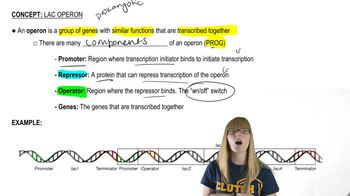Consider the transcription of genes of the lac operon under two conditions: (1) when both glucose and lactose are present and (2) when glucose is absent and lactose is present. Describe the comparative levels of transcription of lac operon genes under these conditions, and explain the molecular basis for the difference.
Table of contents
- 1. Introduction to Genetics51m
- 2. Mendel's Laws of Inheritance3h 37m
- 3. Extensions to Mendelian Inheritance2h 41m
- 4. Genetic Mapping and Linkage2h 28m
- 5. Genetics of Bacteria and Viruses1h 21m
- 6. Chromosomal Variation1h 48m
- 7. DNA and Chromosome Structure56m
- 8. DNA Replication1h 10m
- 9. Mitosis and Meiosis1h 34m
- 10. Transcription1h 0m
- 11. Translation58m
- 12. Gene Regulation in Prokaryotes1h 19m
- 13. Gene Regulation in Eukaryotes44m
- 14. Genetic Control of Development44m
- 15. Genomes and Genomics1h 50m
- 16. Transposable Elements47m
- 17. Mutation, Repair, and Recombination1h 6m
- 18. Molecular Genetic Tools19m
- 19. Cancer Genetics29m
- 20. Quantitative Genetics1h 26m
- 21. Population Genetics50m
- 22. Evolutionary Genetics29m
12. Gene Regulation in Prokaryotes
Lac Operon
Problem 16d
Textbook Question
In the lac operon, what are the likely effects on operon gene transcription of the mutations described in a–e?
Mutation of the lacI gene affecting the DNA-binding site of the protein
 Verified step by step guidance
Verified step by step guidance1
Understand the role of the lacI gene: The lacI gene encodes the lac repressor protein, which binds to the operator region of the lac operon to inhibit transcription in the absence of lactose.
Identify the mutation's effect: A mutation in the DNA-binding site of the lacI protein would likely impair its ability to bind to the operator region of the lac operon.
Predict the impact on transcription: If the lacI protein cannot bind to the operator, the operon will remain transcriptionally active, even in the absence of lactose, because the repressor cannot block RNA polymerase from initiating transcription.
Consider the role of lactose: Normally, lactose (or allolactose) binds to the lac repressor, causing it to release from the operator. In this case, the mutation renders the repressor ineffective regardless of lactose presence.
Conclude the overall effect: The mutation would likely result in constitutive expression of the lac operon genes, meaning they would be transcribed continuously, regardless of environmental lactose levels.
 Verified video answer for a similar problem:
Verified video answer for a similar problem:This video solution was recommended by our tutors as helpful for the problem above
Video duration:
2mPlay a video:
Was this helpful?
Key Concepts
Here are the essential concepts you must grasp in order to answer the question correctly.
Lac Operon Structure
The lac operon is a set of genes in E. coli that are involved in the metabolism of lactose. It consists of three structural genes (lacZ, lacY, and lacA) and regulatory elements, including the promoter and operator. The operon is controlled by the lacI gene, which encodes the repressor protein that binds to the operator to inhibit transcription in the absence of lactose.
Recommended video:
Guided course

Lac Operon Overview
Role of the LacI Repressor
The lacI gene produces the lac repressor, a protein that binds to the operator region of the lac operon, preventing RNA polymerase from transcribing the downstream genes. When lactose is present, it binds to the repressor, causing a conformational change that releases the repressor from the operator, allowing transcription to occur. Mutations in the lacI gene can disrupt this regulatory mechanism.
Recommended video:
Guided course

Trp Repressor
Effects of Mutations on Gene Expression
Mutations in the lacI gene that affect the DNA-binding site of the repressor can lead to either a loss of function or altered binding affinity. If the repressor cannot bind to the operator, the operon will be constitutively expressed, leading to continuous transcription of the lac genes regardless of lactose presence. Conversely, a mutation that enhances binding could prevent transcription even when lactose is available.
Recommended video:
Guided course

Maternal Effect
Related Videos
Related Practice
Textbook Question
780
views


